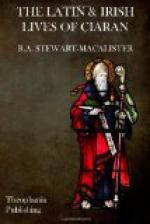The Hymn of Colum Cille.—This composition has not been preserved in its entirety. Fragments of it are introduced into the Homiletic Introduction of VG, which are enough to identify it with a short hymn to be found in the Irish Liber Hymnorum, and published by Bernard and Atkinson in their edition of that compilation.[29] It is as follows—
Alto et ineffabile apostolorum coeti celestis Hierosolimae sublimioris speculi sedente tribunalibus solis modo micantibus Quiaranus sanctus sacerdos insignis nuntius
inaltatus est manibus angelorum celestibus consummatis felicibus sanctitatum generibus quem tu Christe apostolum mundo misisti hominem gloriosum in omnibus nouissimis temporibus
rogamus Deum altissimum per sanctorum memoriam sancti Patrici episcopi Ciarani prespeteri Columbaeque auxilia nos deffendat egregia ut per illorum merita possideamus premia
Obviously the third stanza, with its reference to Colum Cille himself, is a later addition, so that only the first two stanzas belong to the original hymn. The sixth line, quem tu Christe, is quoted in the section of VG referred to; but the three other excerpts, lucerna..., custodiantur..., propheta..., do not appear in the text before us: nor do the surviving stanzas justify the extravagant praise said to have been heaped on the composition at Clonmacnois—though no doubt a composition by Colum Cille, had it only the artless simplicity of a nursery jingle, would have been sure of an appreciative audience. However, the text seems to indicate something much more elaborate, and probably the original composition was an acrostic, like Colum Cille’s great Altus Prosator.[30] The two authentic stanzas of the Liber Hymnorum are incorporated in the metrical patchwork at the end of LB.




